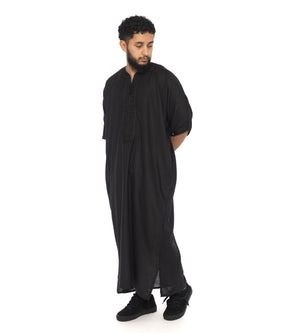The Moroccan thobe, known locally as the "djellaba," is more than just a piece of clothing—it's a rich symbol of Moroccan heritage and tradition. With its roots deeply embedded in the cultural fabric of Morocco, the djellaba is celebrated for its unique design, versatility, and the way it bridges the past with the present.
The Origins and History of the Moroccan Thobe
The djellaba has been a staple in Moroccan thobe attire for centuries. Originating from the ancient Berber tribes, this traditional garment has evolved over time while maintaining its core features. Traditionally made from wool, the djellaba was designed to protect against the harsh desert climate, offering warmth in winter and coolness in the heat. The garment has historically symbolized modesty and social status, reflecting the wearer's place within Moroccan society.
Distinctive Features of the Moroccan Thobe
Design and Construction
The Moroccan thobe is characterized by its long, flowing design, which extends from the shoulders to the ankles. It features a hood, known as the "qob," which provides additional protection from the sun and sand. The garment is often distinguished by its wide sleeves and loose fit, ensuring comfort and ease of movement.
Made from various fabrics such as wool, cotton, or synthetic materials, the djellaba can vary greatly in texture and weight. While wool is commonly used for its warmth, lighter fabrics are preferred during the hotter months.
Color and Decoration
The colors and decorations of a djellaba can range from simple and understated to elaborate and vibrant. Traditional colors include earthy tones like browns, beiges, and greens, but contemporary designs often feature brighter hues and intricate embroidery. The choice of color and decoration can reflect regional styles, personal preferences, or seasonal trends.
The Djellaba in Modern Moroccan Society
Everyday Wear
In contemporary Morocco, the djellaba remains a popular choice for both men and women. It is commonly worn during daily activities, religious events, and family gatherings. The garment's versatility allows it to be adapted for various occasions, making it an essential part of Moroccan fashion.
Fashion and Adaptation
While the traditional djellaba is still widely worn, modern interpretations of the garment have emerged. Designers are now experimenting with new fabrics, patterns, and embellishments, bringing a fresh and contemporary twist to this age-old piece. These modern versions often combine traditional elements with innovative designs, appealing to younger generations and international audiences alike.
The Cultural Significance of the Djellaba
Symbol of Identity
The djellaba is more than just clothing; it is a symbol of Moroccan identity and cultural pride. Wearing a djellaba connects individuals to their heritage and reflects a deep respect for traditional values. During significant cultural and religious events, the djellaba serves as a reminder of the rich history and customs that define Moroccan society.
Influence on Global Fashion
In recent years, the Moroccan thobe has gained international recognition and influence. Designers from around the world have incorporated elements of the djellaba into their collections, highlighting its aesthetic appeal and cultural significance. This global fascination has not only elevated the djellaba’s status but also fostered a greater appreciation for Moroccan craftsmanship and design.
Conclusion
The Moroccan thobe, or djellaba, stands as a testament to Morocco’s rich cultural heritage and its ability to adapt to changing times. From its historical roots to its modern interpretations, the djellaba continues to be a cherished garment that bridges tradition and contemporary style. Its distinctive design, cultural significance, and versatility ensure that it remains an enduring symbol of Moroccan identity and elegance. Whether worn in daily life or showcased on global runways, the djellaba remains a powerful representation of Moroccan tradition and artistry. Visit the official website of newarabia.co.uk





Comments